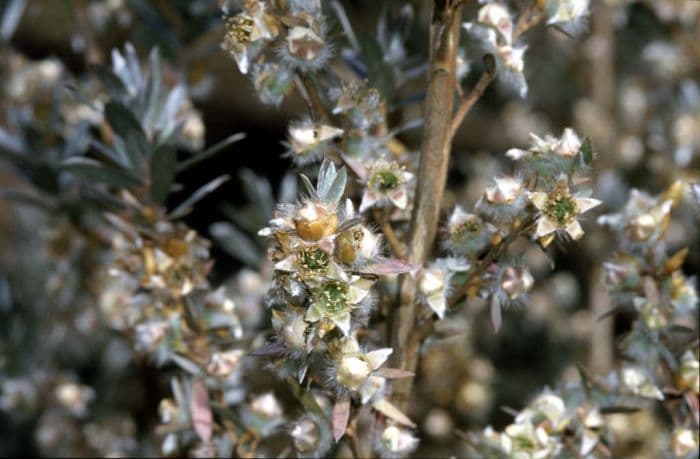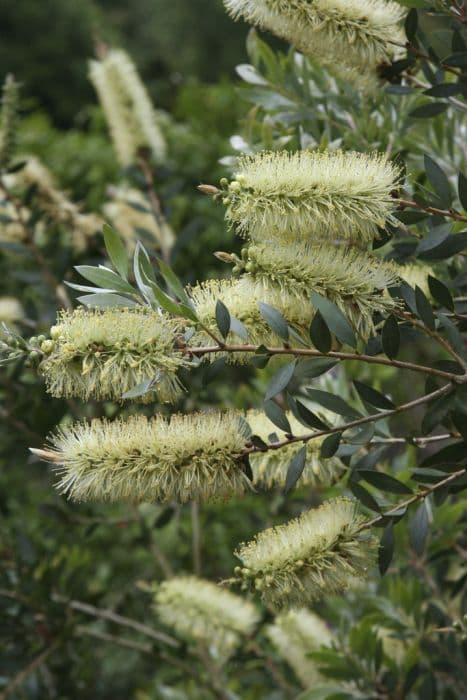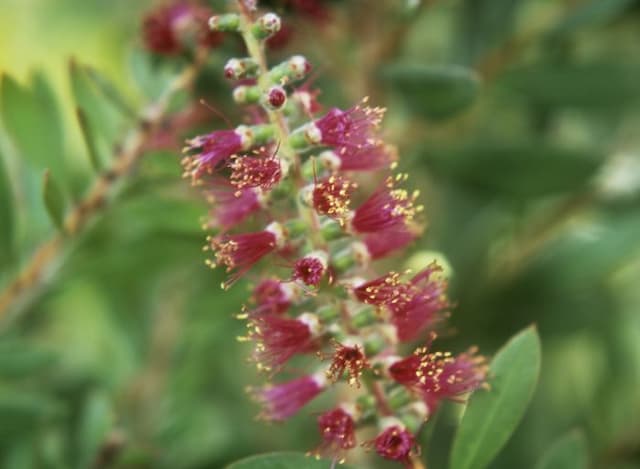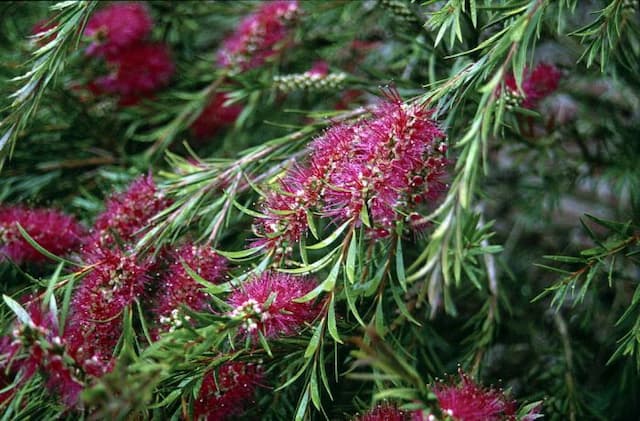Tea Tree Leptospermum 'Silver Sheen'

ABOUT
The Leptospermum 'Silver Sheen', commonly known as the tea tree or New Zealand tea tree, is characterized by its particularly attractive foliage. Each slender leaf is small and narrow, with a delicate appearance that seems to shimmer and dance in the light, giving the plant its descriptive name 'Silver Sheen'. The leaves are a soft grey-green color and are densely packed along the stems, creating a fine, textured look. The tea tree produces small, showy flowers that are typically very attractive to bees and other pollinators. These flowers are usually white, sometimes with a hint of pink, and they have a distinctive, cup-shaped appearance. They add a delightful contrast to the foliage when they bloom, which is usually in late spring or early summer. The bark of the tea tree is another feature that adds to its aesthetic appeal. It has a papery texture and may peel or flake in thin layers which can reveal different shades underneath, contributing further to its ornamental value. Its overall form is often described as open and airy, allowing light to filter through the canopy which enhances the silvery effect of the leaves.
About this plant
 Names
NamesSynonyms
Silver Sheen Tea Tree, Silver Sheen New Zealand Tea Tree.
Common names
Leptospermum 'Silver Sheen'.
 Toxicity
ToxicityTo humans
The Tea Tree 'Silver Sheen' is not commonly known for being toxic to humans. However, as with many plants, individual sensitivity can vary, and some people may experience irritation or allergic reactions upon contact with the plant or its oils. Ingestion is not advised, as plants not typically consumed as food can cause gastrointestinal discomfort or more severe symptoms depending on the amount ingested and individual susceptibility. If suspicion of poisoning arises after ingestion, it is important to seek medical attention.
To pets
The Tea Tree 'Silver Sheen' is similarly not widely recognized as a toxic plant to pets such as dogs and cats. Nonetheless, ingestion of plant material by pets can sometimes lead to gastrointestinal upset, such as vomiting or diarrhea. As pets can vary in their reactions to plants, monitoring for signs of distress and consulting with a veterinarian if any concerning symptoms occur is recommended after ingestion. It is always best to prevent pets from eating ornamental plants.
 Characteristics
CharacteristicsLife cycle
Perennials
Foliage type
Evergreen
Color of leaves
Green
Flower color
White
Height
10 feet (3 meters)
Spread
6 feet (1.8 meters)
Plant type
Shrub
Hardiness zones
9
Native area
Australia
Benefits
 General Benefits
General Benefits- Decorative Aesthetics: The Leptospermum 'Silver Sheen', commonly known as Tea Tree, has attractive silvery-green foliage which adds a shimmering effect to landscapes.
- Privacy Screening: With a dense growth habit, it can be used as a hedge or screen, providing privacy and reducing noise pollution.
- Low Maintenance: Tea Tree is known for being hardy and requires minimal care once established, making it suitable for gardeners of all skill levels.
- Drought Resistance: Once established, Tea Tree is drought tolerant, making it a suitable choice for water-wise gardens in dry regions.
- Wind Resistance: This plant can tolerate and provide protection against winds, making it ideal for coastal or exposed areas.
- Pest and Disease Resistance: Tea Tree is generally resistant to many common plant pests and diseases, reducing the need for chemical treatments.
- Wildlife Attraction: The flowers of Tea Tree attract pollinators such as bees and can also provide habitat for birds and beneficial insects.
- Soil Stabilization: Its root system can help prevent soil erosion on slopes or in areas prone to erosion.
- Adaptability: Tea Tree is adaptable to a wide range of soils and environmental conditions, making it a versatile plant in the landscape.
 Medical Properties
Medical PropertiesThis plant is not used for medical purposes.
 Air-purifying Qualities
Air-purifying QualitiesThis plant is not specifically known for air purifying qualities.
 Other Uses
Other Uses- Privacy screening: Leptospermum 'Silver Sheen', commonly known as Tea Tree, can be used as a dense hedge or screen to provide privacy due to its compact and bushy growth habit.
- Topiary: With its fine leaf texture and sturdy nature, Tea Tree can be trimmed and shaped into various topiary forms for decorative purposes in formal gardens.
- Erosion control: The robust root system helps to stabilize soil, making Tea Tree suitable for planting in areas prone to erosion or on slopes.
- Windbreak: The dense foliage of Tea Tree acts as an excellent windbreak, making it ideal for protecting more sensitive plants in a garden.
- Foliage contrast: The silver-colored leaves provide a beautiful contrast when planted alongside plants with dark green or colorful foliage.
- Sound barrier: When planted in large numbers, the thick growth of Tea Tree can help reduce noise from traffic or neighboring properties.
- Cultural significance: In some cultures, the Tea Tree is planted in gardens for its symbolic value, such as representing tranquility or resilience.
- Bonsai: Tea Tree's small leaves and attractive bark make it a suitable candidate for bonsai cultivation.
- Wildlife habitat: Its dense foliage provides shelter for small birds and insects, making it a beneficial addition to a wildlife-friendly garden.
- Seasonal interest: Although largely an evergreen, the Tea Tree can have subtle seasonal changes that add interest to the garden landscape with variations in foliage color.
Interesting Facts
 Feng Shui
Feng ShuiThe Tea Tree is not used in Feng Shui practice.
 Zodiac Sign Compitability
Zodiac Sign CompitabilityThe Tea Tree is not used in astrology practice.
 Plant Symbolism
Plant Symbolism- Purification – The aromatic oils found in Leptospermum, also known as Tea Tree, can purify the air and are often associated with cleanliness.
- Protection – With its dense foliage, Tea Tree is often considered a protective barrier, symbolizing shelter and safety.
- Healing – Tea Tree oil has medicinal properties, making the plant symbolic of healing and restoration.
- Perseverance – Able to thrive in tough conditions, Tea Tree symbolizes resilience and the ability to overcome challenges.
- Renewal – The plant's ability to regrow even after being cut back represents renewal and the cyclical nature of life.
 Water
WaterThe New Zealand Tea Tree (Leptospermum 'Silver Sheen') prefers consistent moisture and should be watered when the top inch of the soil feels dry to the touch. In the growing season, this may mean watering approximately once a week, using around one to two gallons for an outdoor shrub depending on its size and the weather conditions. During dormant periods, usually in winter, reduce the frequency to once every two to three weeks. Ensure proper drainage to avoid waterlogging, which can cause root rot.
 Light
LightThe New Zealand Tea Tree thrives in full sun conditions, meaning it should receive at least six hours of direct sunlight each day. The best spot for this plant is in an area where it's exposed to unfiltered, bright light for the majority of the day. It can tolerate partial shade, but flowering is usually more prolific with full sun exposure.
 Temperature
TemperatureThe ideal temperature range for the New Zealand Tea Tree is between 50°F and 75°F. It can tolerate minimum temperatures down to about 20°F and maximum temperatures well into the 80s, but it is not a frost-hardy plant, so it should be protected from freezing temperatures. Preferred conditions are cool to mild, avoiding extremes of heat or cold.
 Pruning
PruningPrune the New Zealand Tea Tree to maintain its shape, manage its size, and remove any dead or diseased wood. Pruning is best done in late winter or early spring before new growth begins. Pruning at this time minimizes stress on the plant and allows for vigorous springtime growth. You can lightly prune after flowering to encourage bushiness.
 Cleaning
CleaningAs needed
 Soil
SoilThe best soil mix for the Australian Tea Tree is one that is well-draining with a slightly acidic to neutral pH between 5.5 and 7.0. A mixture of two parts potting soil, one part perlite, and one part peat moss is ideal for ensuring good drainage while retaining adequate moisture.
 Repotting
RepottingThe Australian Tea Tree should be repotted every two to three years, or when it has outgrown its current container. Spring is the best time for repotting to allow the plant to establish in the new pot before the growing season.
 Humidity & Misting
Humidity & MistingThe Australian Tea Tree prefers moderate to high humidity levels. Aim for a humidity level around 50% for optimal growth, avoiding excessively dry air which may cause leaf tips to brown.
 Suitable locations
Suitable locationsIndoor
Place in bright, indirect light and ensure good air circulation for the Australian Tea Tree.
Outdoor
Plant in full sun to part shade in well-draining soil for the Australian Tea Tree.
Hardiness zone
9-11 USDA
 Life cycle
Life cycleThe Leptospermum 'Silver Sheen', also known as New Zealand Tea Tree or Manuka, begins its life cycle with seed germination, occurring when environmental conditions such as moisture and temperature are conducive. Following germination, seedlings emerge and establish themselves, slowly developing a robust root system and foliage. As the plant enters the vegetative stage, it experiences rapid growth of leaves and stems, with the distinctive silver-frosted appearance becoming prominent. Once mature, the tea tree produces small, showy flowers that are typically white, and this flowering stage indicates the plant's readiness for pollination and subsequent seed production. After pollination, seed capsules form and mature, eventually releasing seeds to start the next generation. Over time, the plant may reach the end of its lifecycle, which can span several years, after which it dies back, potentially leaving seedlings to continue the species.
 Propogation
PropogationPropogation time
Spring-Early Autumn
The most popular method of propagating the Leptospermum 'Silver Sheen', commonly known as the Tea Tree, is through semi-hardwood cuttings. This is typically done in late summer to early fall when the new growth has started to mature and harden slightly. Cuttings of about 4 to 6 inches (10 to 15 centimeters) in length are taken from healthy branches, with the lower leaves removed to expose a clean stem. The base of the cutting is then treated with a rooting hormone to encourage root growth and planted in a well-draining soil mix. The cuttings are kept in a warm, humid environment, and roots usually develop within a few weeks to a couple of months. Proper care during this time includes ensuring high humidity, consistent moisture, and avoiding direct strong sunlight until roots are established.









